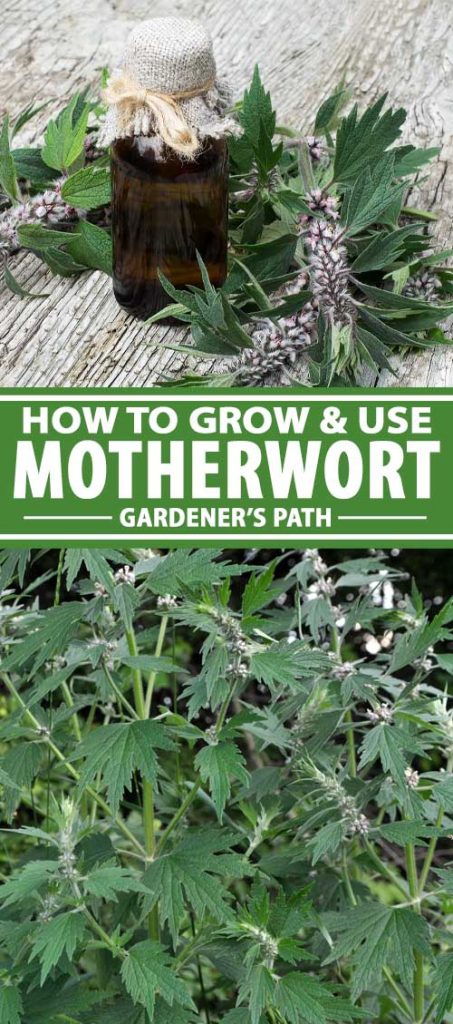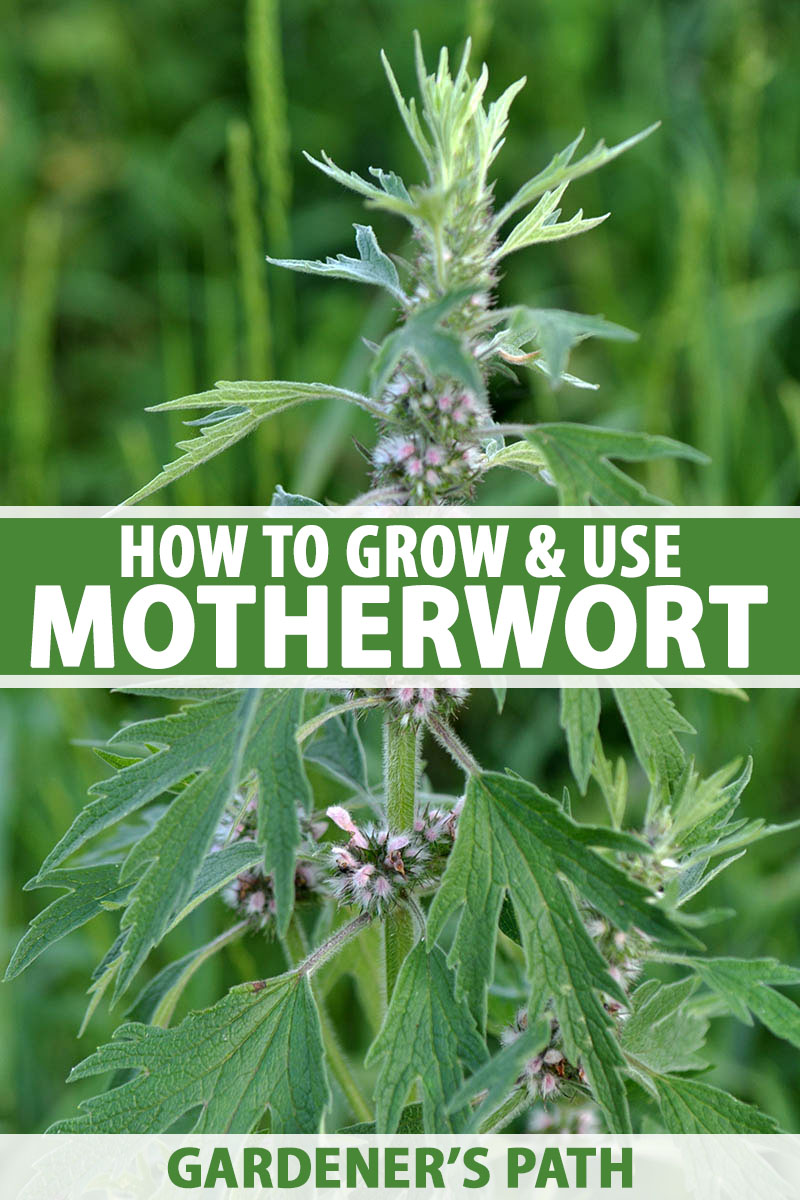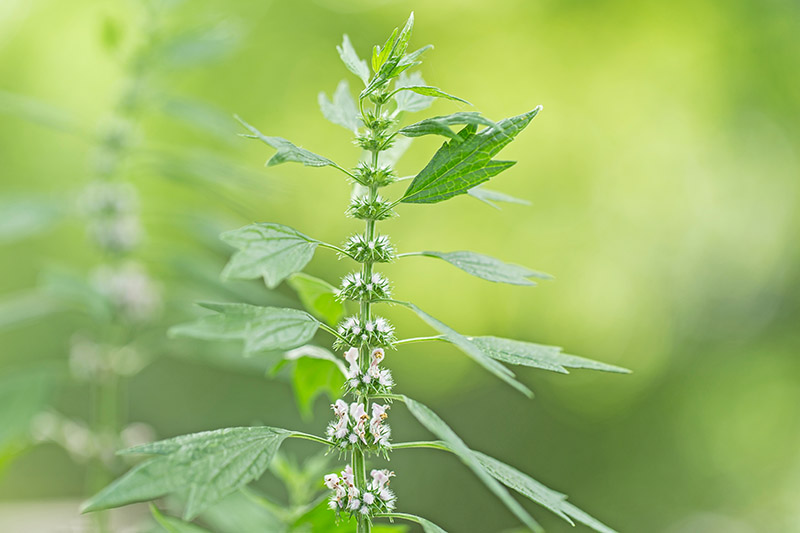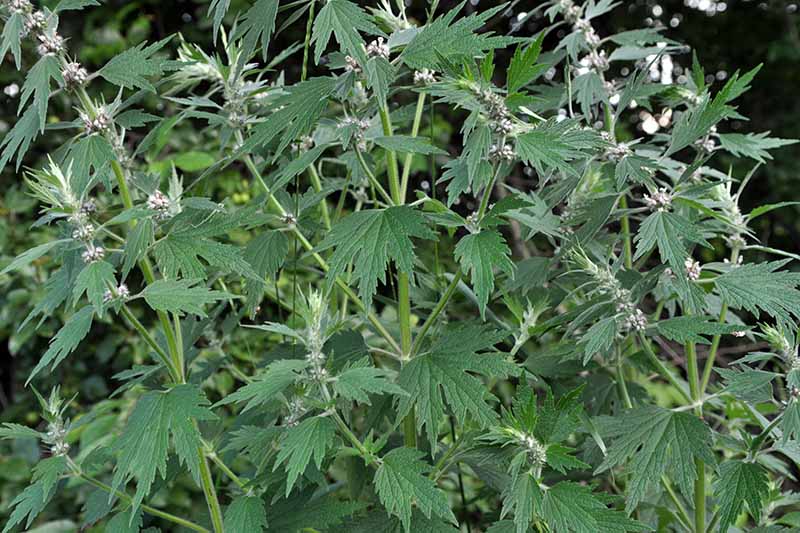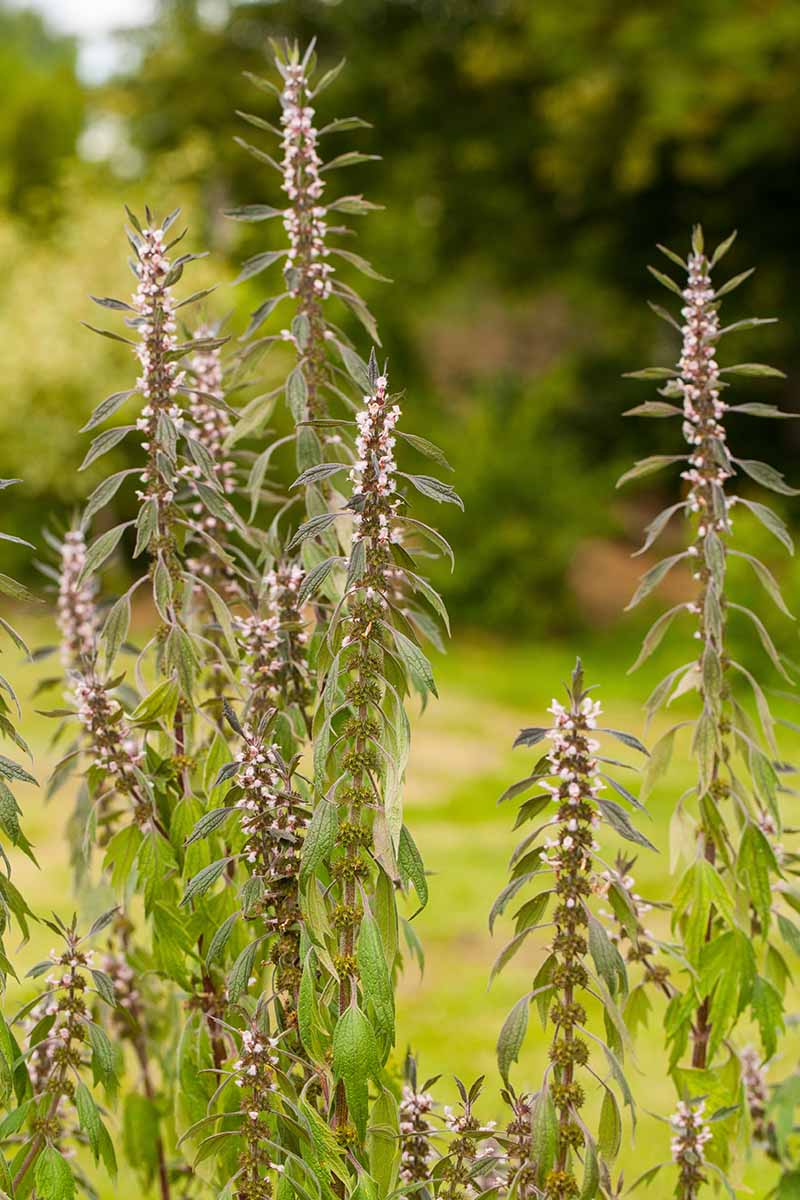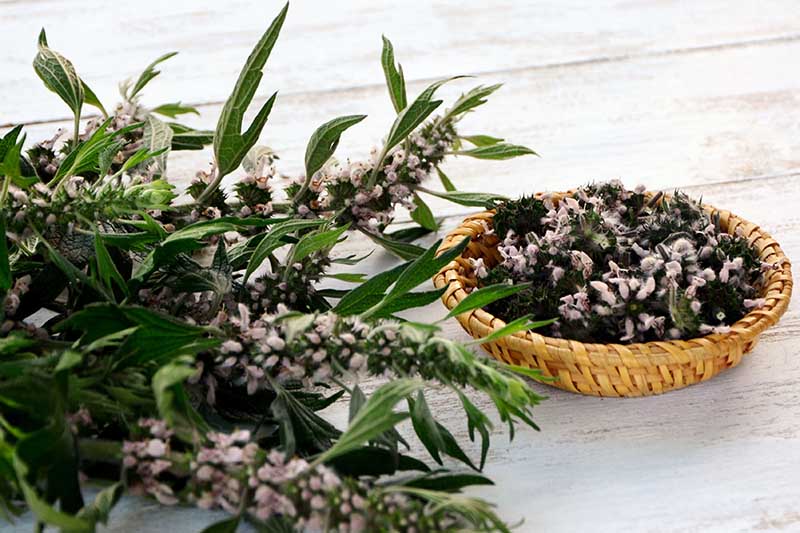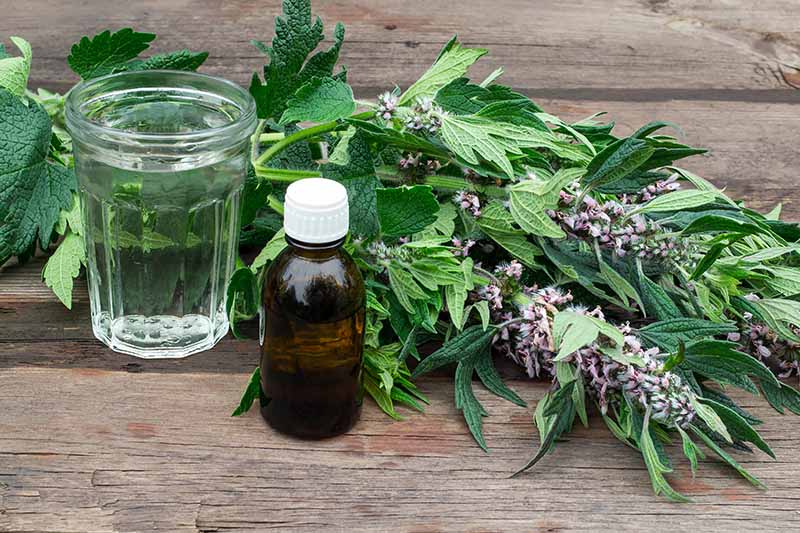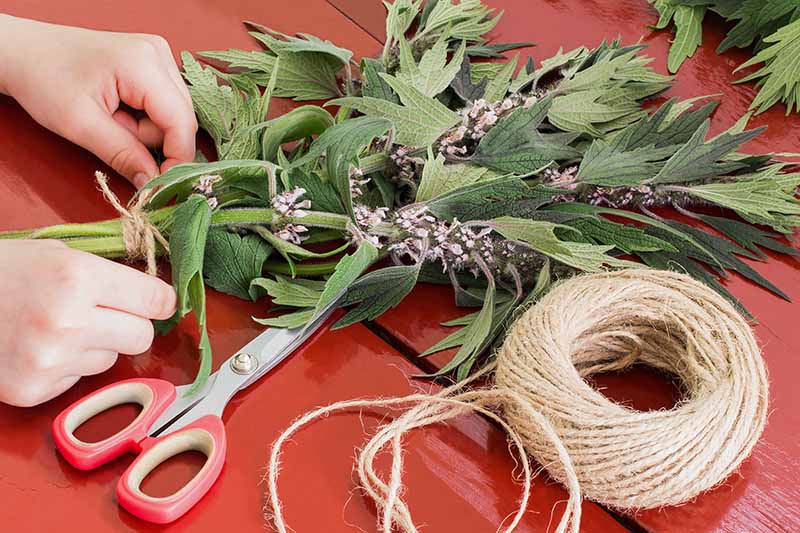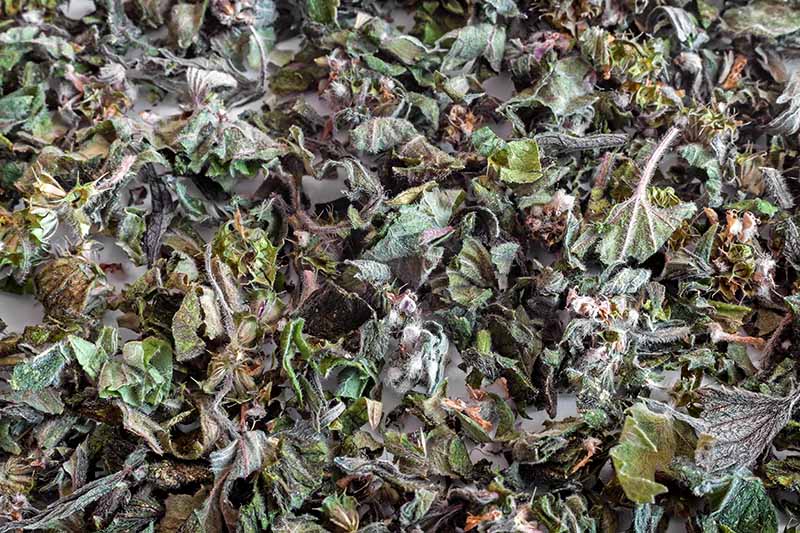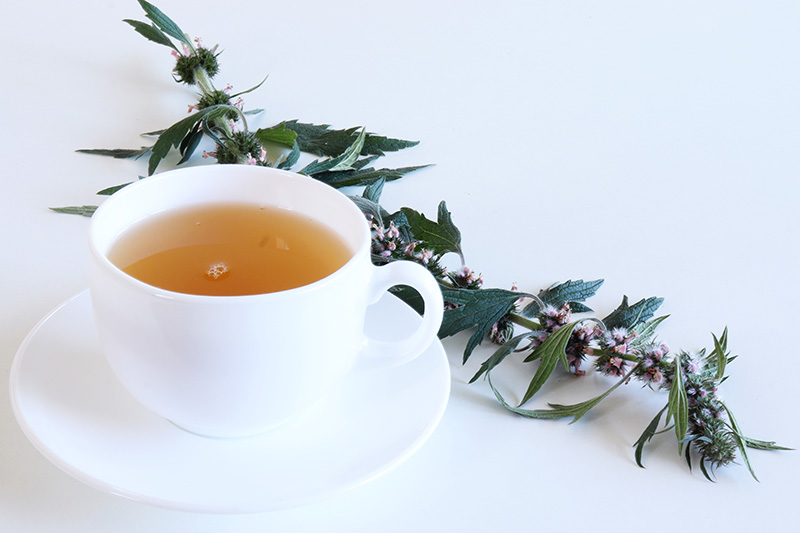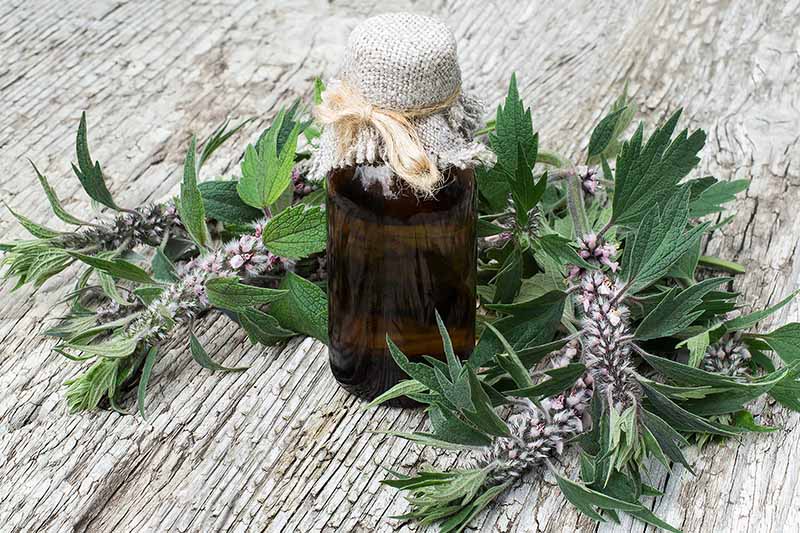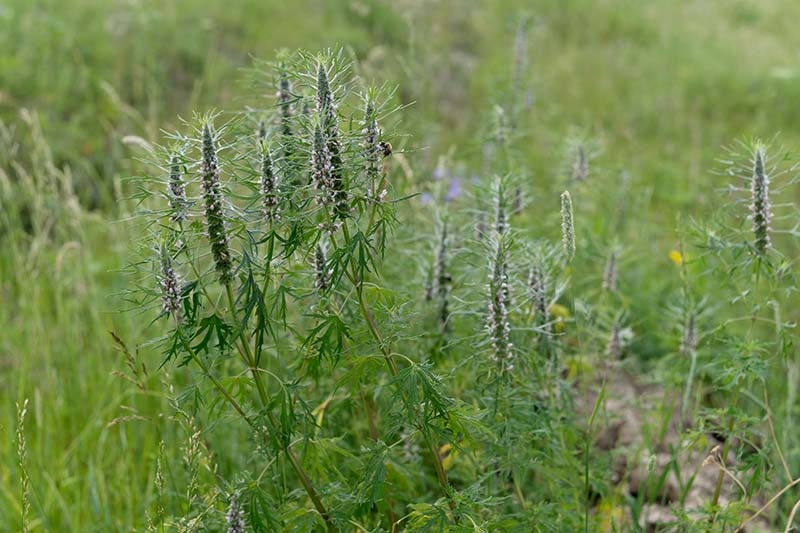This medicinal herb has a reputation for reducing anxiety, feelings of restlessness, and stress. It seemed to be calling my name. But I had never grown motherwort before, and truthfully, I didn’t have any idea what it looked like, how to harvest it, or how to use it at home. We link to vendors to help you find relevant products. If you buy from one of our links, we may earn a commission. Ready to learn how to grow your own crop at home, for visual interest, to attract pollinators, and to make your own herbal medicine? Here’s what’s to come in this article:
What Is Motherwort?
A spiky, weedy, clumping perennial herb that can reach up to five feet tall, motherwort is often found growing wild, especially in wet areas such as floodplains and riverbanks, or along streams. It is also a common weed along roadsides and in neglected gardens.
It is a member of the Lamiaceae family, and similar to many of its minty relatives, it is a vigorous grower that can sometimes be considered invasive. The plant produces clusters of pink to purple flowers that rise along prickly sepals, blooming from midsummer through early fall. It also has a unique leaf structure. The lower leaves have five cleft lobes with coarse teeth, and leaves with three lobes grow higher on the stem. The uppermost leaves are oblong with one pair of coarse teeth.
Motherwort’s botanical name Leonurus cardiaca means “lionhearted.” This may be related to the plant’s reputation for bringing strength during times of emotional stress. The flower spike is also thought to bear resemblance to a lion’s tail. Motherwort has long been used in herbal medicine and as an ornamental plant, and it attracts bees and other pollinators to the garden.
Cultivation and History
This herb likely originated in central and northern Asia, spreading to western Europe by sometime around the 17th century. Believed to have been brought to North America in the 19th century by colonists, and has now naturalized widely throughout the continent.
Motherwort has long been used medicinally in many different traditions. In ancient China, it was thought to promote longevity. In 17th century Europe it was used for heart palpitations, difficult labor, and promoting menstruation. In Nicholas Culpeper’s book “The Complete Herbal,” published in 1653, he describes motherwort as an herb “to strengthen [the heart] and make a merry, cheerful, blithe soul” and says, “it makes women joyful mothers of children, and settles their wombs as they should be, therefore we call it Motherwort.” Also saying it is “held to be of much use for the trembling of the heart,” he claims this is where the name cardiaca derives from.
In the late 19th and early 20th centuries, American practitioners of Eclectic medicine used it to treat nervous conditions and to improve female reproductive health. According to Daniel E. Moerman in his book “Native American Ethnobotany,” Native American tribes including the Delaware, Micmac, Mohegan, Shinnecock, and Oklahoma people used an infusion of motherwort as a uterine tonic for women, and it was used by the Cherokee and Iroquois people as a digestive and nervous system support.
Medicinal Use
For centuries, this bitter-tasting herb has been used by mothers, and it was a very common medicine prescribed by midwives. It has a history of being used to reduce stress during childbirth, postpartum depression, and menopause symptoms, as well as helping to regulate menstrual cycles and reduce symptoms of PMS.
It is also utilized as a nervous system support, specifically to reduce anxiety, irritability, and panic attacks, especially when stress is associated with heart palpitations. Body into Balance: An Herbal Guide to Holistic Self-Care In recent years, it has been studied as an herbal treatment for hyperthyroidism. Preliminary research suggests that it can bind to TSH receptors, and prevent the conversion of thyroid hormone T4 to the active form T3, essentially slowing down thyroid function. Groves says motherwort pairs well with lemon balm, another herb indicated for hyperthyroidism, particularly in an herbal formula for treating Graves’ disease. Germany’s Commission E, an official government agency similar to the US Food and Drug Administration (FDA) that focuses specifically on herbal treatments, has authorized use of motherwort as a treatment for anxiety-induced rapid heartbeat and for hyperthyroidism. In vitro studies have demonstrated its ability to have an effect on cardiac function, though further research is needed. A dearth of well-designed human studies documenting its safe and effective use means we still lack sufficient scientific evidence to support these claims.
Propagation
Motherwort is easy to grow from seed or transplants, or by division. This hardy perennial can grow in many different conditions, but for best results, look for a spot with well draining soil, and amend beds or containers with compost before planting.
Cold Stratification
If starting from seed or transplants, it is necessary to cold stratify seeds for a few weeks prior to planting. This is simply a measure to trick seeds into thinking that they have just experienced winter and the time has come to sprout. To cold stratify seeds, soak for 12-24 hours and then put them in a plastic bag filled with sand and peat. Seal the bag and place it in the refrigerator for 10 days, checking regularly for moisture and spritzing lightly if the mix becomes dry.
From Seed
First, read the instructions on purchased seed packets to see if they have been previously cold stratified for planting. If not, stratify the seeds for 10 days. Once the seeds are prepped, they can be sown directly into the garden. Broadcast seeds in late spring and cover with a very thin 1/8-inch layer of soil. They should take about a week to sprout, and strong seedlings can be thinned to 2-3 feet apart. You can also choose to sow seeds directly in the garden in late fall. This way, there is no need to cold stratify your seeds first, as the cold winter weather will take care of this process for you in most growing zones. Motherwort also self sows easily.
From Seedlings and Transplanting
Start cold stratified seeds in flats a few weeks before the last frost date in your area. Plant them out in a garden bed amended with compost once seedlings have reached 4-6 inches tall. Space plants 2-3 feet apart.
From Divisions
Since motherwort grows quickly and spreads via rhizomes, established plants can easily be dug up, divided, and relocated in new areas of the garden. Divide in spring or fall during dormancy. Dig a hole twice the width of the roots, spread the rhizome out and gently place it in the hole. Cover it up with soil until the hole is filled in and water well. You can read more about dividing perennials here.
How to Grow
One unique feature of motherwort is that it grows well in any type of light. You can plant it wherever you have room, whether your chosen location is in full sun or bathed in shade. It is also adaptable to most soil types, though moist, rich soil with a slightly alkaline pH of 7.7 is ideal.
While it is helpful to keep this herb watered well while it is young, once established, it is hardy and drought tolerant. Even better, it is also very rarely affected by pests or disease. Motherwort is a vigorous grower, and care must be taken to ensure that it doesn’t spread more than desired. To prevent self seeding, cut foliage back to 3-5 inches after flowering and before the seeds have a chance to mature. This keeps the plant from going to seed and spreading everywhere.
It also spreads via an extensive root system, and roots should be divided each season to prevent a garden takeover! Remove divided roots from the garden to compost, or pot up and give them to friends.
Growing Tips
Water young plants every few days, until they are well established. To avoid unwanted spread, try growing it in containers or raised beds. A great bee forage plant, include motherwort in areas where you want to attract pollinators.
Where to Buy
Motherwort can often be found growing wild. Considered a weed by some, you won’t find cultivated varieties available for purchase. Perhaps the easiest way to acquire motherwort is to find a patch already growing in your yard or a friend’s yard, and cut some divisions. You may also be able to purchase seeds or plants from local nurseries or farms that specialize in medicinal herbs.
Managing Pests and Disease
Though motherwort is a hardy perennial that is rarely harmed by pests or disease, there are still a couple of problems to watch out for.
Spider Mites
In rare instances, spider mites can damage the leaves of the plant. This tends to happen during prolonged periods of drought. You can treat leaves with a solution of soapy water to get rid of the mites. Just add 2 tablespoons of a mild biodegradable liquid soap to a gallon of water, and spray off the undersides of the leaves to remove the mites.
Powdery Mildew
Sometimes, white powdery fungus can develop on the plant foliage, hindering plant growth and vigor. If powdery mildew develops, remove infected parts of the plant and destroy them. You can reduce instances of this disease by pruning overcrowded areas to increase air circulation, and avoid overwatering. Read more about combating powdery mildew here.
Harvesting
The ideal time to harvest motherwort is in early to midsummer, just as the plant is beginning to flower. But you can also harvest the large, soft leaves in the pre-flowering stage. Cut and collect the top third of the stems, including the leaves, flowers, and buds. Once the herb has finished flowering, it quickly loses its vitality. You will notice that the leaves suddenly seem to look thin and brown, and you will have to wait until next season to harvest more. Don’t forget your gloves and pruning shears! The flower stalks can be a bit prickly.
Preserving and Making Medicine
This herb is best consumed or tinctured while it’s fresh, but the flowers and leaves can also be dried for later use. To dry, hang bundles of stems in a dark, airy location, or lay them on a screen in a dark, dry room.
A dehydrator set to low heat can also be used to dry your harvest more quickly. Once your motherwort has dried fully, which should take no more than a few hours, remove the leaves and flowers from the stems, and store them in a tightly sealed glass jar in a dark pantry. Find more tips on drying herbs here.
Motherwort can be brewed as a tea for medicinal purposes, but its intense bitterness makes this a less than pleasant option. If you do choose to drink motherwort tea, I recommend combining it with other more pleasant herbs like lemon balm or peppermint, to mask the flavor.
More commonly, this herb is made into a tincture or herbal glycerite, or infused in vinegar. To make any of these infusions, begin by preparing the herb. Whether you are using fresh or dried motherwort, it should be chopped, crushed, or ground into small pieces.
Make a Tincture
To tincture motherwort, simply fill a glass jar about one-half to two-thirds full with the crushed fresh or dried herb, and cover it with 100-proof vodka. Let this sit for 4 to 6 weeks in a dark cupboard, shaking daily to agitate the mixture. Strain out the herb. The final product should look very dark and have a bitter taste.
It should keep for several years in your pantry if stored in an airtight container in a cool, dark location. Tip: To hide the bitter taste, you can dilute doses of tincture in tea or water before consuming.
Make a Glycerite
A glycerite tincture is very similar to an alcohol-based tincture, except food grade vegetable glycerine is used to make it instead of vodka. Like alcohol, glycerin is a useful medium that may be used to extract and preserve the active chemical compounds of herbs. This is a great option if you prefer to avoid alcohol, and it has the added benefit of a sweeter taste. To make a motherwort glycerite, fill a jar about half full with dried herb or two-thirds full with fresh motherwort. In a separate jar, mix three parts food grade vegetable glycerin with one part water and shake to combine. Pour the liquid mixture over the herb, filling the jar. Cover with a tight lid and set aside in a dark cupboard for 4-6 weeks, shaking daily to agitate the mixture. Strain and store in an airtight container in a cool dark location. The glycerite will keep for one to two years.
To Make Infused Vinegar
Herbal vinegar can be used in cooking, and it has the additional advantageous properties of the vinegar itself, which can be useful for aiding digestion and remedying other issues. The process of making herbal infused vinegar is very similar to what you would do to create a tincture or glycerite. Fill a jar halfway with dried herb or three-fourths full with fresh. Cover with your vinegar of choice; I recommend unfiltered, unpasteurized apple cider vinegar with the mother. Place a lid on the jar, preferably a nonreactive plastic lid, as vinegar will corrode metal. Let the jar sit in the pantry for a month, shaking daily. Strain out the solids, and keep in a cool, dark, dry spot. It should stay fresh for one to two years.
Strong and robust, calming and supportive, it is certainly a plant worth knowing how to grow and use. I am excited to make use of my abundant motherwort supply this year.
Do you have experience growing or using motherwort? Tell us your stories in the comments below! If you are excited about growing motherwort, check out these other easy to grow medicinal herbs next:
Grow Faassen’s Catmint for Durable Summer Color Cozy Up with Chamomile: Growing and Harvesting a Classic How to Grow and Use Epazote Herb
© Ask the Experts, LLC. ALL RIGHTS RESERVED. See our TOS for more details. Uncredited photos: Shutterstock. With additional writing and editing by Allison Sidhu. The staff at Gardener’s Path are not medical professionals and this article should not be construed as medical advice intended to assess, diagnose, prescribe, or promise cure. Gardener’s Path and Ask the Experts, LLC assume no liability for the use or misuse of the material presented above. Always consult with a medical professional before changing your diet or using plant-based remedies or supplements for health and wellness.

